- Top: Adirondack Spruce
- Back, and Sides: Brazilian Rosewood
- Bracing: Scalloped X, Adirondack
- Neck: Mahogany
- Finish: Nitrocellulose lacquer
- Herringbone purfling
- Ivoroid binding
- Fretboard: Ebony
- Bridge: Ebony
- Peghead veneer: Ebony
- Scale Length: 25.5 inches
- Nut Width: 1 11/16 inches
- Tuners: Waverly
-
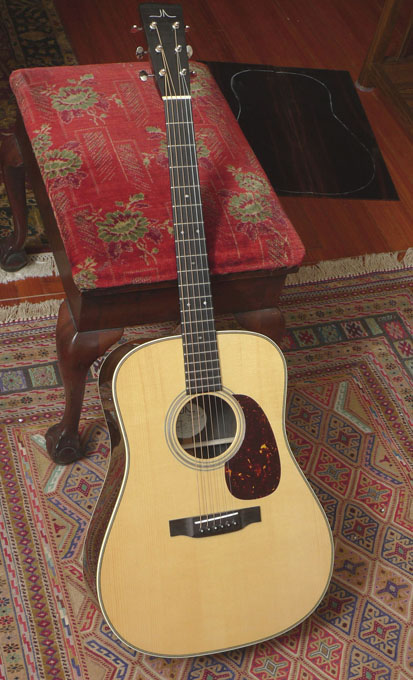 This is a new Allison Brazilian Rosewood dreadnought. Austin-based John Allison was a key part of the Collings Guitar team for years. John is now one of the most sought-after independent makers of fine instruments in the southwest. His guitars are carried by a number of top dealers in the U.S… and we’ve just snagged this brand new, wonderful Brazilian– a custom order guitar. Allison’s attention to detail is astounding. You just have to see and play this great brazilian. Right off the bench, it’s loud and beguiling, and it will only get better over time.
This is a new Allison Brazilian Rosewood dreadnought. Austin-based John Allison was a key part of the Collings Guitar team for years. John is now one of the most sought-after independent makers of fine instruments in the southwest. His guitars are carried by a number of top dealers in the U.S… and we’ve just snagged this brand new, wonderful Brazilian– a custom order guitar. Allison’s attention to detail is astounding. You just have to see and play this great brazilian. Right off the bench, it’s loud and beguiling, and it will only get better over time. -
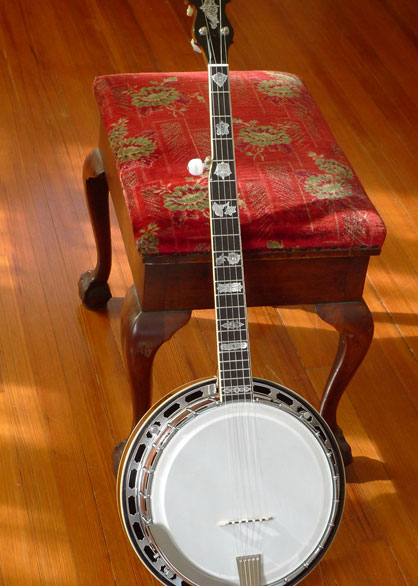 Late 1970s, but in almost unplayed condition. Bluegrass banjo players seek out these 70’s Whyte Eagles, known for their tone and craftsmanship. It was a pretty short window of only about five years, when these banjos were made with this kind of craftsmanship. They blow away most any banjo made and marketed (from any country) in the 60s, 70s and 80s– and they show no logos on headstock– just beautiful mother of pearl. It’s the No. 4310 “Whyte Eagle”. Based on late 1920’s Vega Griffin (Tubaphone #9) style inlays, with engraved, carved heel. Sunburst finish maple banjo, Gibson-style 2 piece flange, full height 20 hole archtop tone ring, dual coordinator rods, flamed maple resonator, maple neck, chrome finish. Neck is butterfly with ebony strip on back of neck, down the center. Just set up, with new tailpiece, and new head, by Dave Trexle and ready to play: loud, clear, and bright. With original hard shell case.
Late 1970s, but in almost unplayed condition. Bluegrass banjo players seek out these 70’s Whyte Eagles, known for their tone and craftsmanship. It was a pretty short window of only about five years, when these banjos were made with this kind of craftsmanship. They blow away most any banjo made and marketed (from any country) in the 60s, 70s and 80s– and they show no logos on headstock– just beautiful mother of pearl. It’s the No. 4310 “Whyte Eagle”. Based on late 1920’s Vega Griffin (Tubaphone #9) style inlays, with engraved, carved heel. Sunburst finish maple banjo, Gibson-style 2 piece flange, full height 20 hole archtop tone ring, dual coordinator rods, flamed maple resonator, maple neck, chrome finish. Neck is butterfly with ebony strip on back of neck, down the center. Just set up, with new tailpiece, and new head, by Dave Trexle and ready to play: loud, clear, and bright. With original hard shell case. -
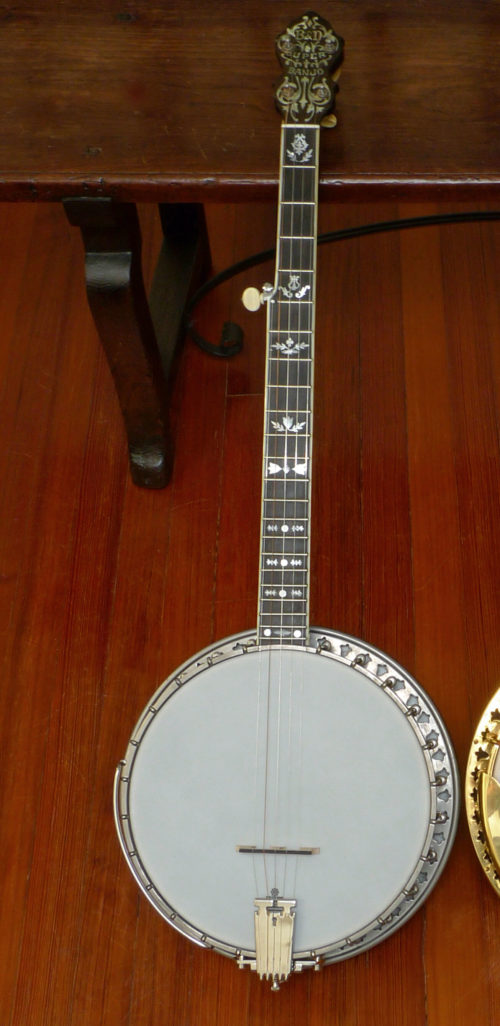 This is a superb sounding 5 string banjo. Original nickel plating. • Bacon & Day Super, 5-string Banjo (Style A) Serial number: 25892 (early 1928) • Resonator, stamped on inside (in nickel-laminated maple): Bacon Banjo Co., Inc. Groton, CT. U.S.A. Dec. 20th, 1927 • Conversion, 5 string neck (original neck was probably a tenor or plectrum); Presumably, this neck is newer than the banjo– yet the advanced MOP fret markers are as found on the earliest versions of B&D Super banjos. We assume this neck was built by one of the best U.S. “conversion” builders – with a re-use of the original MOP inlay at the peghead plus the dowel stick. Maple neck, with steel reinforcing rod. Fretboard is beautiful jet-black ebony; multi-layer neck bindings. Fretboard is a very comfortable 1 3/8 inches wide at the nut, 1 7/8 wide where fretboard meets body. • Nickel plated • 22 frets • Scale length: 27 inches • Extended Maple resonator– nickel laminated on inside • Original flat Tulip-hole flange (not the “add-on” round-hole resonator of earlier years). • Original, top of the line Type III Silver Bell tone ring (No Hole tone ring) original to the instrument (this is the most sought-after, advanced Silver Bell tone ring, introduced early 1927). • Original 2 band Grover geared tuning pegs • Fults tailpiece, and included a variety of Fults tone pins. Bob Fults made the best tailpieces available. And his tone pins let you tweak the tone of your banjo. There are several interchangeable Fults pins included here– ivory, ebony, lead, sterling silver, brass, and copper. Plus a “tone lock”. (Bob Fults recently retired, and these highly sought after Fults tailpieces and pins are no longer available.) In its original hard shell Lifton case. $3750.
This is a superb sounding 5 string banjo. Original nickel plating. • Bacon & Day Super, 5-string Banjo (Style A) Serial number: 25892 (early 1928) • Resonator, stamped on inside (in nickel-laminated maple): Bacon Banjo Co., Inc. Groton, CT. U.S.A. Dec. 20th, 1927 • Conversion, 5 string neck (original neck was probably a tenor or plectrum); Presumably, this neck is newer than the banjo– yet the advanced MOP fret markers are as found on the earliest versions of B&D Super banjos. We assume this neck was built by one of the best U.S. “conversion” builders – with a re-use of the original MOP inlay at the peghead plus the dowel stick. Maple neck, with steel reinforcing rod. Fretboard is beautiful jet-black ebony; multi-layer neck bindings. Fretboard is a very comfortable 1 3/8 inches wide at the nut, 1 7/8 wide where fretboard meets body. • Nickel plated • 22 frets • Scale length: 27 inches • Extended Maple resonator– nickel laminated on inside • Original flat Tulip-hole flange (not the “add-on” round-hole resonator of earlier years). • Original, top of the line Type III Silver Bell tone ring (No Hole tone ring) original to the instrument (this is the most sought-after, advanced Silver Bell tone ring, introduced early 1927). • Original 2 band Grover geared tuning pegs • Fults tailpiece, and included a variety of Fults tone pins. Bob Fults made the best tailpieces available. And his tone pins let you tweak the tone of your banjo. There are several interchangeable Fults pins included here– ivory, ebony, lead, sterling silver, brass, and copper. Plus a “tone lock”. (Bob Fults recently retired, and these highly sought after Fults tailpieces and pins are no longer available.) In its original hard shell Lifton case. $3750. -
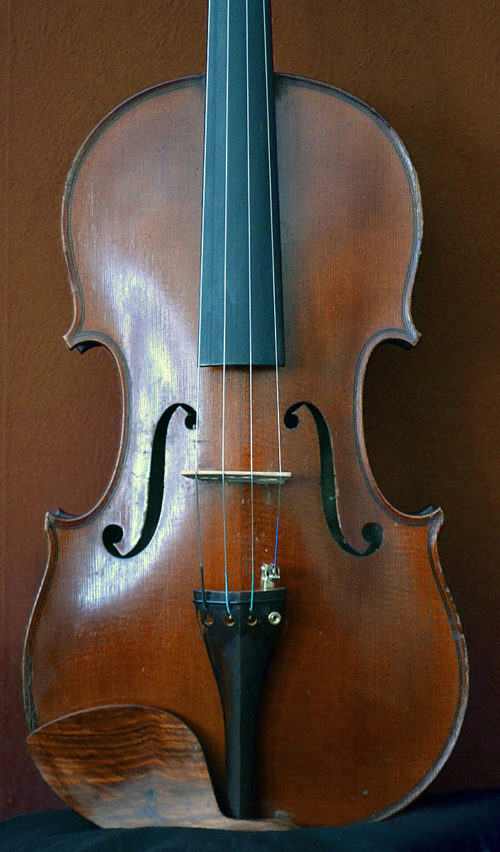 Full size, Charles Fetique violin (French, early 20th century – circa 1930), with original label inside. This is a rich, sonorous instrument. A deep, round tone, that – like all good violins – does not make you work overly hard to attain. It has a darker, lush, round tone that professional players love – and great projection. We recently A-B'd this instrument against $5k+ violins in the area, and there was no comparison, this instrument was louder, more full, more round and full in the bass notes, and all around a stellar performer. This violin would be a great student violin upgrade – for that aspiring violinist who is ready to graduate to, and enjoy, a better instrument than what's typically available in the $4-5K range, at a very attractive price. And, the buyer will have the confidence of both a Letter of Expertise, and a professional appraisal: • Certificate: Jean-Jacques Rampal, Paris, 2014. (This is the letter of expertise, on this violin, from one of the top experts on French Violins, in Paris, France). And: • Written, professional appraisal of the violin, done from personal inspection, from one of the top violin shops/experts in Texas (Jay R. Rury Violins, Dallas), with a valuation of $3,500.00 Both the above documents will be included with the sale. The violin is in excellent condition. There are no sound post, or bass bar cracks. It was professionally set up to play, by Blackerby Violin in Austin. In a modern Tonerelli case. Price: $3250.
Full size, Charles Fetique violin (French, early 20th century – circa 1930), with original label inside. This is a rich, sonorous instrument. A deep, round tone, that – like all good violins – does not make you work overly hard to attain. It has a darker, lush, round tone that professional players love – and great projection. We recently A-B'd this instrument against $5k+ violins in the area, and there was no comparison, this instrument was louder, more full, more round and full in the bass notes, and all around a stellar performer. This violin would be a great student violin upgrade – for that aspiring violinist who is ready to graduate to, and enjoy, a better instrument than what's typically available in the $4-5K range, at a very attractive price. And, the buyer will have the confidence of both a Letter of Expertise, and a professional appraisal: • Certificate: Jean-Jacques Rampal, Paris, 2014. (This is the letter of expertise, on this violin, from one of the top experts on French Violins, in Paris, France). And: • Written, professional appraisal of the violin, done from personal inspection, from one of the top violin shops/experts in Texas (Jay R. Rury Violins, Dallas), with a valuation of $3,500.00 Both the above documents will be included with the sale. The violin is in excellent condition. There are no sound post, or bass bar cracks. It was professionally set up to play, by Blackerby Violin in Austin. In a modern Tonerelli case. Price: $3250. -
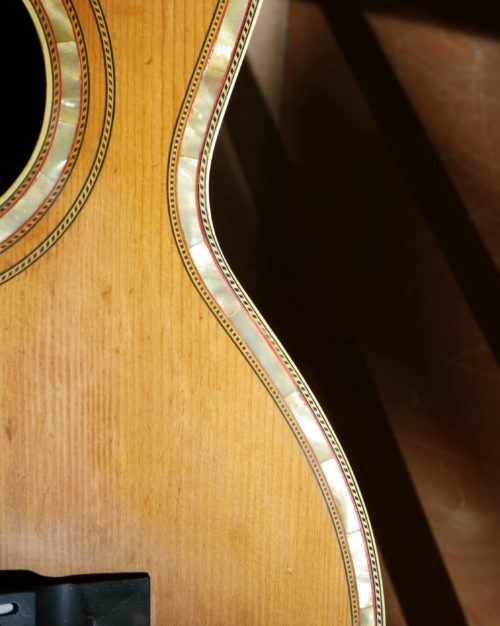 Circa 1912 Mother of Pearl Inlaid Guitar The guitar is extensively inlayed with mother of pearl . The guitar was restored in 2001, work that included converting the instrument to X-bracing, reproduction ebony bridge, reproduction small maple bridge plate. It’s signed inside by the restorer, “B. Lehmann 2001” (Bernie Lehmann, well known luthier in New York.) The guitar has no stamps or labels, but it was probably made by George Bauer – because of many stylistic similarities. The guitar is set up and ready to play. As many guitars of this era, the tone is tilted toward very bright, glassy, brazilian rosewood trebles, not fuller bass. Solid Spruce top Solid Brazilian Rosewood back and sides MOP inlays, fretboard, rosette, and bindings X-braced Original tuners Width at lower bout: 13 1/2 inches Scale Length: 24 7/8 inches Nut Width: 1 ¾ inches V shaped neck .... no longer available....
Circa 1912 Mother of Pearl Inlaid Guitar The guitar is extensively inlayed with mother of pearl . The guitar was restored in 2001, work that included converting the instrument to X-bracing, reproduction ebony bridge, reproduction small maple bridge plate. It’s signed inside by the restorer, “B. Lehmann 2001” (Bernie Lehmann, well known luthier in New York.) The guitar has no stamps or labels, but it was probably made by George Bauer – because of many stylistic similarities. The guitar is set up and ready to play. As many guitars of this era, the tone is tilted toward very bright, glassy, brazilian rosewood trebles, not fuller bass. Solid Spruce top Solid Brazilian Rosewood back and sides MOP inlays, fretboard, rosette, and bindings X-braced Original tuners Width at lower bout: 13 1/2 inches Scale Length: 24 7/8 inches Nut Width: 1 ¾ inches V shaped neck .... no longer available.... -
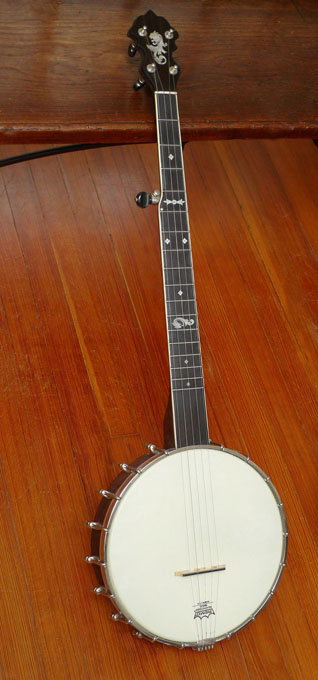 This is a one-of-a-kind custom banjo, from one of the country’s most respected luthiers, based in Appomattox, Virginia. I love this banjo for picking on the couch– it won’t put your back out, picking it up and putting it down, or crush your cat or your sweetheart. It’s lightweight, and with a custom-size head. But it packs beautiful full tone, not the tinny nasal sound from most open back banjos. It’s five or so years old, but with very little wear.
This is a one-of-a-kind custom banjo, from one of the country’s most respected luthiers, based in Appomattox, Virginia. I love this banjo for picking on the couch– it won’t put your back out, picking it up and putting it down, or crush your cat or your sweetheart. It’s lightweight, and with a custom-size head. But it packs beautiful full tone, not the tinny nasal sound from most open back banjos. It’s five or so years old, but with very little wear.- Dark stained maple rim, and neck
- 11 inch pot
- Ebony fretboard
- Engraved dragon inlay in peghead
- Custom MOP inlays
- Bound neck
- No Knot tail piece (Pat. Nov. 19 1901)
- 18 lug
- Brass hoop tone ring
- Dowell stick construction
- nut width 1-¼ inch
- scale: 25- ½ inches
- maple rim diameter: 10- ½ outside
- maple rim thickness: 7/16 inches
- Dark stained maple rim, and neck
- 11 inch pot
- Ebony fretboard
- Engraved dragon inlay in peghead
- Custom MOP inlays
- Bound neck
- No Knot tail piece (Pat. Nov. 19 1901)
- 18 lug
- Brass hoop tone ring
- Dowell stick construction
- nut width 1-¼ inch
- scale: 25-½ inches
- maple rim diameter: 10- ½ outside
- maple rim thickness: 7/16 inches
- With original case.
-
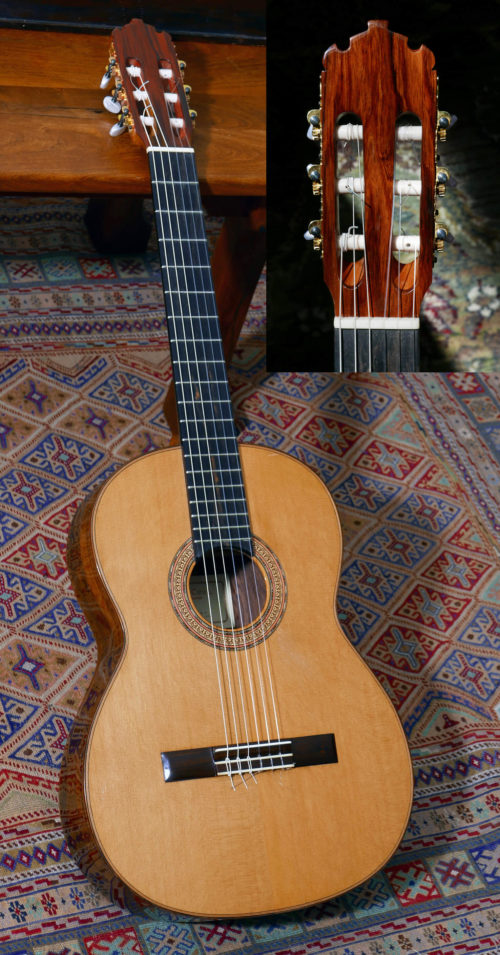 Acquired from the original owner – who bought this wonderful instrument directly from David Caro in the mountain town of the maker, one of the best luthiers that Paracho, Mexico has ever produced – in the mid 90’s and hand-carried it to California where it was lightly played. And it remains in remarkable original condition. The maker is David Caro, also known as David Caro Leonardo, or David Caro L. (In Mexico, the last/last name, in this case “Leonardo”, is the mother’s maiden name that is formally added after a person’s last [paternal] name but typically dropped in all but formal situations, documents etc.) Caro’s best instruments are among the best of a small, elite group that honed their craft at the top levels, and also benefited from visits and master classes given in Paracho by some world class luthiers from Spain, Germany, and the USA such as Felix Manzanero, Antonio Raya Pardo, Jose Romanillos, Thomas Humphery, and Herman Hauser III. Only a few Paracho luthiers have stood out over the years – Jose Navarro, Arturo Huipe, Abel Garcia, Enos Hernandez (his best work), German Vasquez Rubio, and Caro among them. See the enclosed photos from Fretboard Journal magazine, Spring 2008, that featured David Caro prominently in the feature article in that issue on Paracho luthiers. Paracho is an originally Tarascan village that sits in a high valley at 7,300 feet altitude, in the state of Michoacán, a relatively little visited state but renowned for its diversity and great beauty – and for some of the best classical guitar luthiers in the Americas. It extends from the Pacific coast, and is crossed by the Sierra Madre Del Sur in its southern part and by high volcanic mountains in its northern axis. When this guitar was made, in 1996, David Caro was at the height of his craft. And soon after, he was the first luthier to be added to the GSA calendar. This instrument is among the very best guitars ever made by Caro. And we love the model designation, it’s signed by hand on the label, “Mdo. 500”, i.e. “model 500” – sounds like a sports car name. Model 500 was the top model from Caro, in 1995/96 – using top woods, and also the best bindings, and all details. In those years, Caro’s best concert instruments went from model 100 at the base level, then ascending in tone woods and overall construction details to 200, 300, 400, then reaching the top level of “500”. So we’re calling this instrument, “el Quinientos”. (Spanish for “the 500” – nice ring to that – it’s pronounced “key-knee-éntose”) Several things make this guitar stand out as a gem: • It’s the top model from this luthier in the 1990’s • The great original condition • Scale length of 648mm. This scale length is reminiscent of Herman Hauser I’s guitars, and is firmly in the school of the shorter 650 range, not the longer scale lengths that crept in, in the last quarter of the 20th century. This is a great scale length – and note the nut width is a typical nut width of a full size classical guitar. And the neck thickness is great – on the thinner side. This combination makes it a joy to play and so easy to play – but the tone is superb. The full tone, and volume are better than most longer scale guitars. • Light weight/construction, that really allows it to sing. Its total weight, with strings, is a remarkably lithe 1430 grams • And it has great combination of woods: • Palo Escrito back and sides, bridge, and headplate veneer. DALBERGIA PALOESCRITO, is a true rosewood, a great wood that over the years came to be favored by the top luthiers in Paracho – for their top models. It sounds like Brazilian rosewood, but a tad different, and it’s not as “dark” in tone as Indian rosewood. Palo Escrito is lighter in weight and density than either brazilian or Indian rosewood. And weight, is of course part of the equation of a guitar that does translate to tone. Palo Escrito makes this guitar really breathe, and resonate. The lighter weight of this guitar is its charm, that translates to tone – slightly more airy and open, less “closed”, and with full round basses. The tone is clear, with superb string separation, as from the best spruce over rosewood guitars. Surprising volume – but it perhaps produces the best tone, in more delicate playing where you want each note to stand out – that’s of course called good “string separation”: the notes in a run or chord don’t all “blend together” but each note is discernable. And we think it’s accurate to say that this guitar, with its light weight and 648 scale length and combination of woods, has a tone that leans to a great Flamenco negra tone. Fast attack on the trebles, with a touch of growl in the bass when you play them hard. Yet the guitar responds very well to a light touch as well. If you’re looking for another ho-hum, non-descript spruce over Indian rosewood classical tone, this instrument is not for you. • Spruce top – European Alpine spruce • Ebony fingerboard • Ebony reinforcing strips, back of neck • Ebony heel cap • Beautiful rosette, with a hearts & rope pattern (another homage to Bernabe). • Palo Escrito is also used in the binding, back center strip, tie block, and purfling • The headstock shape is an homage to Paulino Bernabe. • Fan strutting, with 5 braces. The braces are very thin, and also scalloped – contributing to the great tone of the instrument. The scale length of the guitar, if it's not on the longer side, allows the luthier to be use more delicate bracing, adding to tone. (Longer scale length guitars produce more tension on the top due to the higher string tension inherent in a longer scale, so luthiers typically have to brace more strongly with longer scale lengths.) • And there is unique, 2-rosewood cleat application under the bridge – one cleat added by Caro at time of construction, on either end of the bridge, on the underside of top, for stability of the top wood beneath the bridge ends. It's worked well. • Good saddle height– and the neck is very straight, and there will never be any neck bowing issues or issue with too high action. Condition: 100% crack-free All original, thin lacquer finish Frets, and fretboard show very little wear A few nicks and dings, and a small amount of fingernail marks in the “pick guard” area. Overall, the condition is what you’d expect from an instrument that’s been played, carefully, for maybe a year, not 20+ years. But the tone is aged, open, clear – benefiting from more than two decades of aging and drying of the woods. Scale length: 648mm Nut Width: 52mm (2 2/32 inches) String spacing at nut: 45mm (1 ¾ inches) Width at lower bout: 14 ¼ inches Body depth, at bottom: 4 inches Body depth, at neck/body joint: 3 ¾ inches Weight (fully strung): 1430 grams (3.15 pounds) In a modern, hard shell case. Price: $4,750.
Acquired from the original owner – who bought this wonderful instrument directly from David Caro in the mountain town of the maker, one of the best luthiers that Paracho, Mexico has ever produced – in the mid 90’s and hand-carried it to California where it was lightly played. And it remains in remarkable original condition. The maker is David Caro, also known as David Caro Leonardo, or David Caro L. (In Mexico, the last/last name, in this case “Leonardo”, is the mother’s maiden name that is formally added after a person’s last [paternal] name but typically dropped in all but formal situations, documents etc.) Caro’s best instruments are among the best of a small, elite group that honed their craft at the top levels, and also benefited from visits and master classes given in Paracho by some world class luthiers from Spain, Germany, and the USA such as Felix Manzanero, Antonio Raya Pardo, Jose Romanillos, Thomas Humphery, and Herman Hauser III. Only a few Paracho luthiers have stood out over the years – Jose Navarro, Arturo Huipe, Abel Garcia, Enos Hernandez (his best work), German Vasquez Rubio, and Caro among them. See the enclosed photos from Fretboard Journal magazine, Spring 2008, that featured David Caro prominently in the feature article in that issue on Paracho luthiers. Paracho is an originally Tarascan village that sits in a high valley at 7,300 feet altitude, in the state of Michoacán, a relatively little visited state but renowned for its diversity and great beauty – and for some of the best classical guitar luthiers in the Americas. It extends from the Pacific coast, and is crossed by the Sierra Madre Del Sur in its southern part and by high volcanic mountains in its northern axis. When this guitar was made, in 1996, David Caro was at the height of his craft. And soon after, he was the first luthier to be added to the GSA calendar. This instrument is among the very best guitars ever made by Caro. And we love the model designation, it’s signed by hand on the label, “Mdo. 500”, i.e. “model 500” – sounds like a sports car name. Model 500 was the top model from Caro, in 1995/96 – using top woods, and also the best bindings, and all details. In those years, Caro’s best concert instruments went from model 100 at the base level, then ascending in tone woods and overall construction details to 200, 300, 400, then reaching the top level of “500”. So we’re calling this instrument, “el Quinientos”. (Spanish for “the 500” – nice ring to that – it’s pronounced “key-knee-éntose”) Several things make this guitar stand out as a gem: • It’s the top model from this luthier in the 1990’s • The great original condition • Scale length of 648mm. This scale length is reminiscent of Herman Hauser I’s guitars, and is firmly in the school of the shorter 650 range, not the longer scale lengths that crept in, in the last quarter of the 20th century. This is a great scale length – and note the nut width is a typical nut width of a full size classical guitar. And the neck thickness is great – on the thinner side. This combination makes it a joy to play and so easy to play – but the tone is superb. The full tone, and volume are better than most longer scale guitars. • Light weight/construction, that really allows it to sing. Its total weight, with strings, is a remarkably lithe 1430 grams • And it has great combination of woods: • Palo Escrito back and sides, bridge, and headplate veneer. DALBERGIA PALOESCRITO, is a true rosewood, a great wood that over the years came to be favored by the top luthiers in Paracho – for their top models. It sounds like Brazilian rosewood, but a tad different, and it’s not as “dark” in tone as Indian rosewood. Palo Escrito is lighter in weight and density than either brazilian or Indian rosewood. And weight, is of course part of the equation of a guitar that does translate to tone. Palo Escrito makes this guitar really breathe, and resonate. The lighter weight of this guitar is its charm, that translates to tone – slightly more airy and open, less “closed”, and with full round basses. The tone is clear, with superb string separation, as from the best spruce over rosewood guitars. Surprising volume – but it perhaps produces the best tone, in more delicate playing where you want each note to stand out – that’s of course called good “string separation”: the notes in a run or chord don’t all “blend together” but each note is discernable. And we think it’s accurate to say that this guitar, with its light weight and 648 scale length and combination of woods, has a tone that leans to a great Flamenco negra tone. Fast attack on the trebles, with a touch of growl in the bass when you play them hard. Yet the guitar responds very well to a light touch as well. If you’re looking for another ho-hum, non-descript spruce over Indian rosewood classical tone, this instrument is not for you. • Spruce top – European Alpine spruce • Ebony fingerboard • Ebony reinforcing strips, back of neck • Ebony heel cap • Beautiful rosette, with a hearts & rope pattern (another homage to Bernabe). • Palo Escrito is also used in the binding, back center strip, tie block, and purfling • The headstock shape is an homage to Paulino Bernabe. • Fan strutting, with 5 braces. The braces are very thin, and also scalloped – contributing to the great tone of the instrument. The scale length of the guitar, if it's not on the longer side, allows the luthier to be use more delicate bracing, adding to tone. (Longer scale length guitars produce more tension on the top due to the higher string tension inherent in a longer scale, so luthiers typically have to brace more strongly with longer scale lengths.) • And there is unique, 2-rosewood cleat application under the bridge – one cleat added by Caro at time of construction, on either end of the bridge, on the underside of top, for stability of the top wood beneath the bridge ends. It's worked well. • Good saddle height– and the neck is very straight, and there will never be any neck bowing issues or issue with too high action. Condition: 100% crack-free All original, thin lacquer finish Frets, and fretboard show very little wear A few nicks and dings, and a small amount of fingernail marks in the “pick guard” area. Overall, the condition is what you’d expect from an instrument that’s been played, carefully, for maybe a year, not 20+ years. But the tone is aged, open, clear – benefiting from more than two decades of aging and drying of the woods. Scale length: 648mm Nut Width: 52mm (2 2/32 inches) String spacing at nut: 45mm (1 ¾ inches) Width at lower bout: 14 ¼ inches Body depth, at bottom: 4 inches Body depth, at neck/body joint: 3 ¾ inches Weight (fully strung): 1430 grams (3.15 pounds) In a modern, hard shell case. Price: $4,750. -
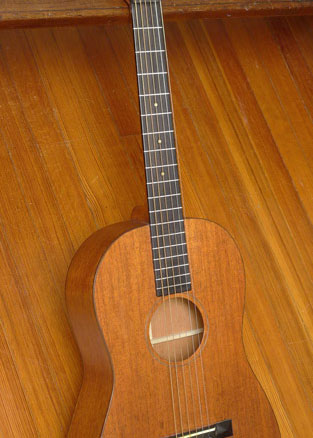 This is a very well made, custom Hawaiian guitar. Made by George Bailey, and signed and dated underside of top, 2009. The body style is similar to an early Ditson. In other regards, its size, sound, and feel is quite similar to a 1930’s Martin 0-17H.
This is a very well made, custom Hawaiian guitar. Made by George Bailey, and signed and dated underside of top, 2009. The body style is similar to an early Ditson. In other regards, its size, sound, and feel is quite similar to a 1930’s Martin 0-17H.- Mahogany back, sides, and top
- Mahogany neck
- Ebony fretboard
- Ebony bridge
- Flush frets, with raised nut and saddle, for Hawaiian playing
- Ladder braced
- Lower Bout width: 13 ¼ inches
- Scale length: 25 inches
- 1 ¾ inch nut
- Crack-free
-
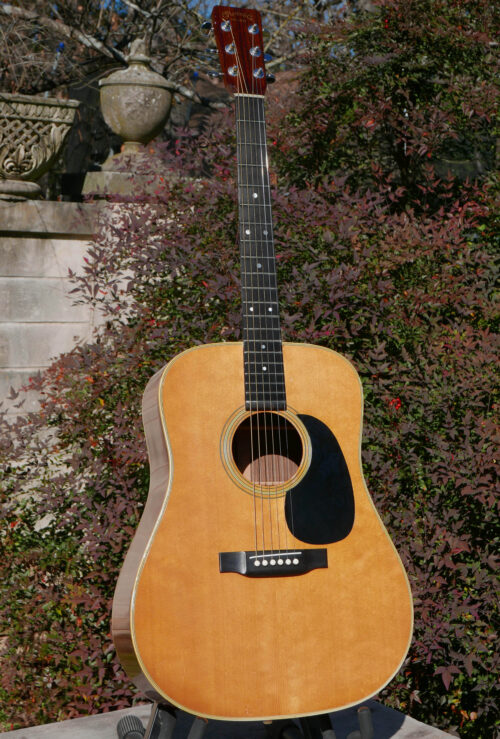 Martin D-28, made very early in 1970. Great tone, great original condition. • The finest, excellent quality Indian Rosewood back, sides, peghead veneer • Sitka Spruce top – and this is not the “streaky” sitka spruce. There are no dark streaks. Note light areas: that is “Bear claw”. • Ebony fingerboard and bridge. • Completely original. This guitar has had no repairs at all. • Original bridge, saddle, nut, pickguard • The guitar has no cracks, anywhere • Addition of a strap button on the neck heel. • Slight marks just above the nut, on bass side, caused from a strap that was worn under the strings on the peghead • The original Black Hard case (one of the last before Martin went to the Blue Plastic cases) is also very clean with no serious scrapes or bruises. One of the finest examples of 60s/early 1970 D28 available. Price: $5250.
Martin D-28, made very early in 1970. Great tone, great original condition. • The finest, excellent quality Indian Rosewood back, sides, peghead veneer • Sitka Spruce top – and this is not the “streaky” sitka spruce. There are no dark streaks. Note light areas: that is “Bear claw”. • Ebony fingerboard and bridge. • Completely original. This guitar has had no repairs at all. • Original bridge, saddle, nut, pickguard • The guitar has no cracks, anywhere • Addition of a strap button on the neck heel. • Slight marks just above the nut, on bass side, caused from a strap that was worn under the strings on the peghead • The original Black Hard case (one of the last before Martin went to the Blue Plastic cases) is also very clean with no serious scrapes or bruises. One of the finest examples of 60s/early 1970 D28 available. Price: $5250. -
Out of stock
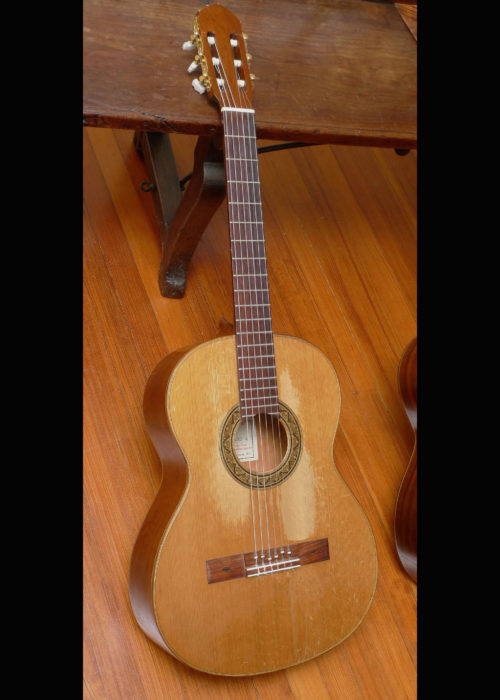
- Cedar top
- Depth at lower bout: 4 3/16 inches
- Width of neck at nut: 2 inches
- Body length: 19 3/4
-
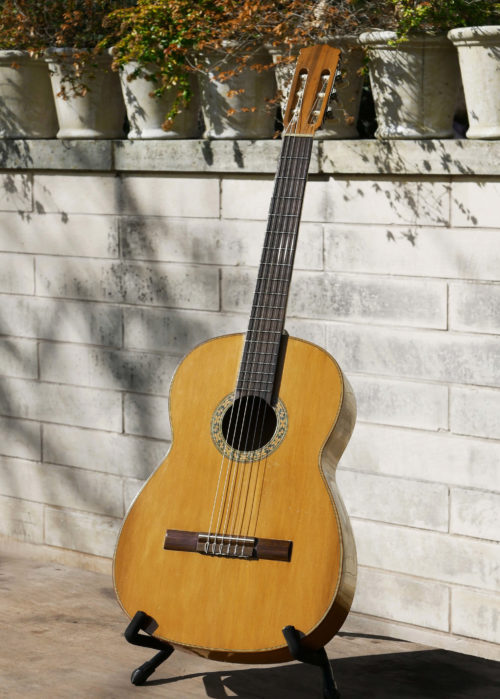 Another instrument from Enos Hernandez of Mexico, one of the best luthiers to ever live in work in Mexico, circa 1970’s. This one is a flamenco Blanca, with the classic cypress back and sides. Like the other Enos Hernandez we have, this one also has a cedar top. The instrument is super light weight, as a Flamenco Blanca should be, and it’s bright and percussive and raspy as a good Blanca should be. There is a scratch (not a crack) on back of guitar (see photo). There are dot position markers – original to the guitar, i.e. not added later – on top edge of fretboard (frets 3,5,7,9 – see photo). Scale length: 660mm Available January 2018 Price: $2950
Another instrument from Enos Hernandez of Mexico, one of the best luthiers to ever live in work in Mexico, circa 1970’s. This one is a flamenco Blanca, with the classic cypress back and sides. Like the other Enos Hernandez we have, this one also has a cedar top. The instrument is super light weight, as a Flamenco Blanca should be, and it’s bright and percussive and raspy as a good Blanca should be. There is a scratch (not a crack) on back of guitar (see photo). There are dot position markers – original to the guitar, i.e. not added later – on top edge of fretboard (frets 3,5,7,9 – see photo). Scale length: 660mm Available January 2018 Price: $2950 -
Out of stock
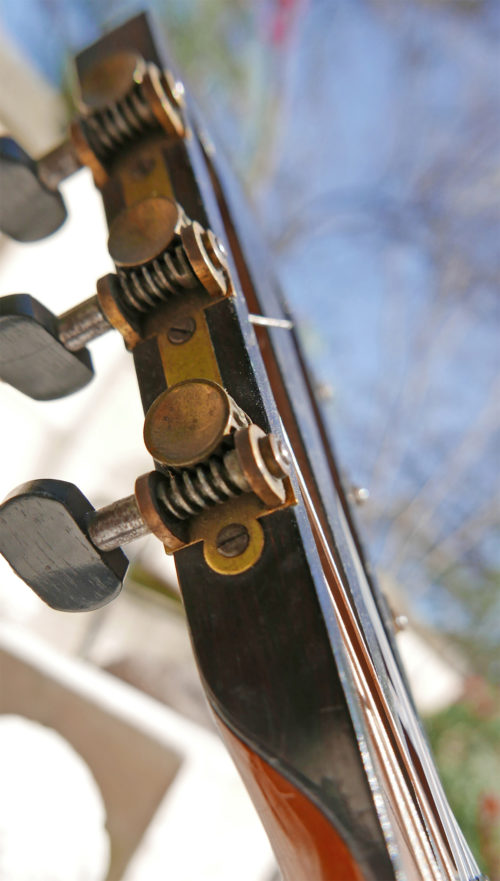 Circa 1860, style 3 guitar built by renowned luthier, James Ashborn of Wolcottville, CT, for William Hall & Son music store. Brazilian rosewood back and sides; Adirondack top; double maple binding (on both back, and front); original coffin case. This guitar is is 100% original, including all original finish, and down to original ebony nut, and original bridge (and saddle) that has never been off the guitar. And it comes in its original wood coffin case, as it left the factory around 1860. This James Ashborn style 3 is rare, and unique because it has brazilian veneer on the neck (not the fretboard which is ebony, but the back of neck), original to the guitar. And, that is very rare for any style/number Ashborn. Also unique to Ashborn’s style 3: his trademark hand-made tuners, have ebony buttons (not rosewood buttons as on his style 1, and 2) And this is a superb sounding Ashborn, unrivaled in tone by any 1850’s/1860’s American guitar we’ve seen and played, including any Martin from that era. Ashborn varied a few details on his guitars (styles 1,2,3, 5), but he did not vary the size of the guitars. He made them all the same body and neck size (unlike Martin for example). They are all the same size. And almost all had spruce/Brazilian veneer on back and sides. As this does. • Nut width is 1 7/8 inches • Width at lower bout: 11 3/8 inches • Scale Length: 24 inches • the action is 4/32 inch on both sides, at 12th string – normal action for this kind of guitar • There are repaired cracks on top, and back of guitar. All professionally repaired. James Ashborn was born in England circa 1816 and came to New England in the late 1830s. Ashborn had his shop in Torrington, but soon after start-up, he began selling guitars to the New York distributor William Hall & Son, whose name appears inside the instruments. From Vintage Guitar magazine: “Ashborn’s design for the guitar was quite innovative for the early 19th century. Instead of making guitars fashioned after the typical parlor-style guitars, he made them in the Spanish style, by taking interior bracing cues from the Spanish while retaining the body of the English guitars. This included a fan brace pattern rather than the more common ladder pattern Ashborn guitars have a very complex dovetail V joint for attaching the head to the neck. The headstock was cut in roughly five steps, using some kind of tracing router, as suggested by the chatter marks on the inside ears of the pegbox. In addition to the complex head design, Ashborn made his own tuning machines in-house. They’re made of brass, very much like contemporary machines, with worm gears, cog gears, and rollers. … Ashborn’s shop was extremely advanced for its time, having a great deal of know-how and technology. Ashborn understood the need to have the technology as well as the skill, but more importantly he discovered a new way of making high-quality instruments that were affordable. He was able to create a factory environment where workers did what they were good at and, with practice, became very fast and consistent. With a new level of consistency in mass production, he created the path followed by other companies such as Martin, Gibson, and Taylor. Using designs ahead of his time, he was able to bring the sound and change to people who otherwise never would have been able to acquire an instrument of this quality.” .... No longer available....
Circa 1860, style 3 guitar built by renowned luthier, James Ashborn of Wolcottville, CT, for William Hall & Son music store. Brazilian rosewood back and sides; Adirondack top; double maple binding (on both back, and front); original coffin case. This guitar is is 100% original, including all original finish, and down to original ebony nut, and original bridge (and saddle) that has never been off the guitar. And it comes in its original wood coffin case, as it left the factory around 1860. This James Ashborn style 3 is rare, and unique because it has brazilian veneer on the neck (not the fretboard which is ebony, but the back of neck), original to the guitar. And, that is very rare for any style/number Ashborn. Also unique to Ashborn’s style 3: his trademark hand-made tuners, have ebony buttons (not rosewood buttons as on his style 1, and 2) And this is a superb sounding Ashborn, unrivaled in tone by any 1850’s/1860’s American guitar we’ve seen and played, including any Martin from that era. Ashborn varied a few details on his guitars (styles 1,2,3, 5), but he did not vary the size of the guitars. He made them all the same body and neck size (unlike Martin for example). They are all the same size. And almost all had spruce/Brazilian veneer on back and sides. As this does. • Nut width is 1 7/8 inches • Width at lower bout: 11 3/8 inches • Scale Length: 24 inches • the action is 4/32 inch on both sides, at 12th string – normal action for this kind of guitar • There are repaired cracks on top, and back of guitar. All professionally repaired. James Ashborn was born in England circa 1816 and came to New England in the late 1830s. Ashborn had his shop in Torrington, but soon after start-up, he began selling guitars to the New York distributor William Hall & Son, whose name appears inside the instruments. From Vintage Guitar magazine: “Ashborn’s design for the guitar was quite innovative for the early 19th century. Instead of making guitars fashioned after the typical parlor-style guitars, he made them in the Spanish style, by taking interior bracing cues from the Spanish while retaining the body of the English guitars. This included a fan brace pattern rather than the more common ladder pattern Ashborn guitars have a very complex dovetail V joint for attaching the head to the neck. The headstock was cut in roughly five steps, using some kind of tracing router, as suggested by the chatter marks on the inside ears of the pegbox. In addition to the complex head design, Ashborn made his own tuning machines in-house. They’re made of brass, very much like contemporary machines, with worm gears, cog gears, and rollers. … Ashborn’s shop was extremely advanced for its time, having a great deal of know-how and technology. Ashborn understood the need to have the technology as well as the skill, but more importantly he discovered a new way of making high-quality instruments that were affordable. He was able to create a factory environment where workers did what they were good at and, with practice, became very fast and consistent. With a new level of consistency in mass production, he created the path followed by other companies such as Martin, Gibson, and Taylor. Using designs ahead of his time, he was able to bring the sound and change to people who otherwise never would have been able to acquire an instrument of this quality.” .... No longer available.... -
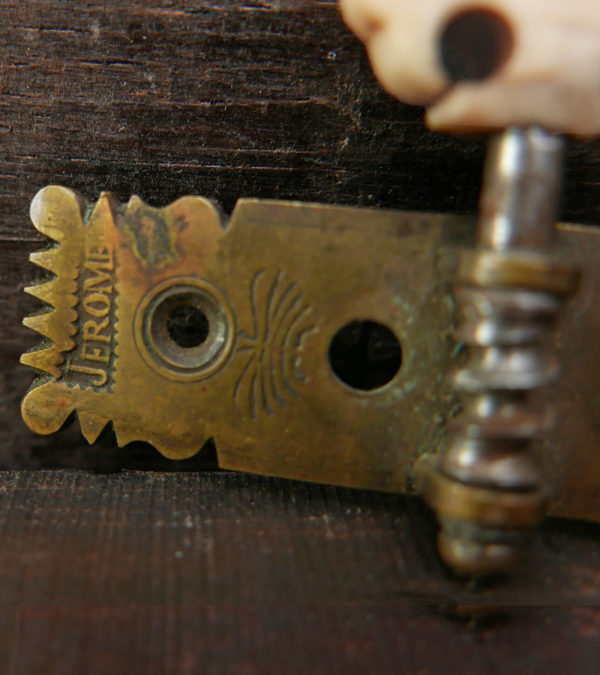 Very rare, early Jerome guitar tuners, made in France. Rare kidney buttons, as seen on higher end Martin guitars from the 1840s, 1850s, and 1860's. Plates, shafts and buttons only. No posts or worm gears (there is one post and one worm gear). Price: $595.
Very rare, early Jerome guitar tuners, made in France. Rare kidney buttons, as seen on higher end Martin guitars from the 1840s, 1850s, and 1860's. Plates, shafts and buttons only. No posts or worm gears (there is one post and one worm gear). Price: $595. -
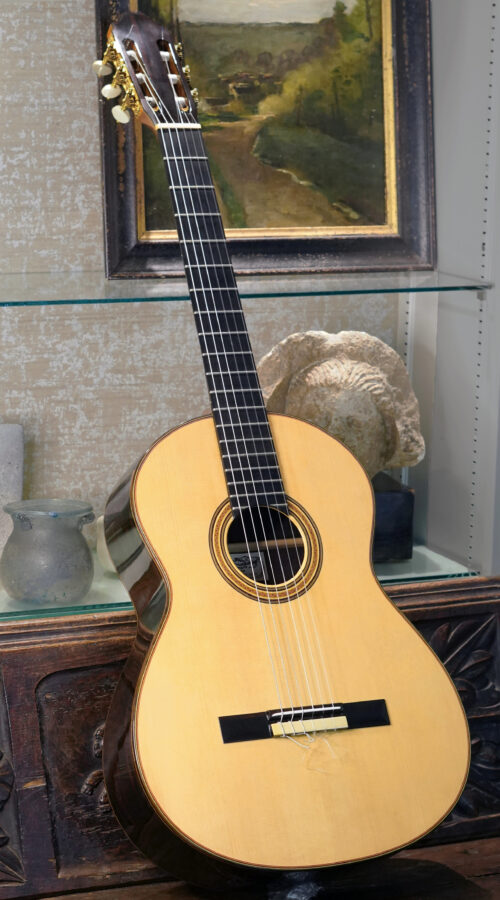 Ken Miller, a great and meticulous luthier, is now retired and is not taking any guitar orders. He started building in early 1960s and in the 1970’s worked at Guild Guitars in Rhode Island, in a variety of positions. He was a full-time luthier with his own brand of guitars from 1999 until retirement in 2015. His guitars are hard to come by – especially his classical guitars as he made only a small number of classicals over the years. “I made all of my Classical and Flamenco guitars in 650mm scale, and with the body size and shape of this one,” said Ken in a recent conversation with us. “The Flamenco guitars had slightly different internals, lower bridge and were made with Spanish Cypress back & sides, and friction pegs. All I made, classical or flamenco, were 650mm scale. I think that those Spanish instruments from about 1900 through the '30's were the cream of the crop. I don't care for the modern, larger classical guitars… My two guitar heroes were Santos Hernandez, and CF Martin.” See/listen to a recording of this guitar being played, in the video posted here. This classical guitar is 20 years old, but you can’t tell by looking at it, it’s near pristine in terms of play wear. It has a big, rich, lush sound. It really excels in the ringing Brazilian rosewood trebles. And it’s one of the few guitars you’ll find where you can get incredible nuance with just a light touch. • Serial number: #70, made in 2003. (Signed as such on label) • Old growth, dark Brazilian Rosewood back/sides, head plate overlay, binding and bridge. (Note, a few “eyes” in the Brazilian on back, were wormholes in the very dark, very old Brazilian that the luthier very well plugged before putting the guitar together.) • The top, and internal bracings are Adirondack (Red) Spruce • There are 7 slender fan braces with a thin horizontal brace under the bridge area between braces 1 and 7 • Ebony fingerboard • Spanish Cedar internal lining as is the neck which has a graphite reinforcement. Fitted to the body with a traditional Spanish foot. • Nut, saddle & bridge tie plate are Fossil Ivory. • Nut is 51.5mm • 650mm scale • Handmade rosette • Oil varnish finish • Gotoh Deluxe tuners with Ivoroid tuner buttons There is one, very small crack that’s difficult to see/photograph on the back of the guitar near the center seam that is near the area of the end pin. The top of the guitar, with no cracks whatsoever, looks virtually unplayed, as does the fretboard and frets. This guitar sold for $6,000 new, in 2003, and it’s about as close to that original ’03 condition as you can get. With its very dark, old growth Brazilian rosewood, it’s easily comparable in build quality, materials, and sound, to classicals in the $8-14K range today. Price: $4,850. With modern case.
Ken Miller, a great and meticulous luthier, is now retired and is not taking any guitar orders. He started building in early 1960s and in the 1970’s worked at Guild Guitars in Rhode Island, in a variety of positions. He was a full-time luthier with his own brand of guitars from 1999 until retirement in 2015. His guitars are hard to come by – especially his classical guitars as he made only a small number of classicals over the years. “I made all of my Classical and Flamenco guitars in 650mm scale, and with the body size and shape of this one,” said Ken in a recent conversation with us. “The Flamenco guitars had slightly different internals, lower bridge and were made with Spanish Cypress back & sides, and friction pegs. All I made, classical or flamenco, were 650mm scale. I think that those Spanish instruments from about 1900 through the '30's were the cream of the crop. I don't care for the modern, larger classical guitars… My two guitar heroes were Santos Hernandez, and CF Martin.” See/listen to a recording of this guitar being played, in the video posted here. This classical guitar is 20 years old, but you can’t tell by looking at it, it’s near pristine in terms of play wear. It has a big, rich, lush sound. It really excels in the ringing Brazilian rosewood trebles. And it’s one of the few guitars you’ll find where you can get incredible nuance with just a light touch. • Serial number: #70, made in 2003. (Signed as such on label) • Old growth, dark Brazilian Rosewood back/sides, head plate overlay, binding and bridge. (Note, a few “eyes” in the Brazilian on back, were wormholes in the very dark, very old Brazilian that the luthier very well plugged before putting the guitar together.) • The top, and internal bracings are Adirondack (Red) Spruce • There are 7 slender fan braces with a thin horizontal brace under the bridge area between braces 1 and 7 • Ebony fingerboard • Spanish Cedar internal lining as is the neck which has a graphite reinforcement. Fitted to the body with a traditional Spanish foot. • Nut, saddle & bridge tie plate are Fossil Ivory. • Nut is 51.5mm • 650mm scale • Handmade rosette • Oil varnish finish • Gotoh Deluxe tuners with Ivoroid tuner buttons There is one, very small crack that’s difficult to see/photograph on the back of the guitar near the center seam that is near the area of the end pin. The top of the guitar, with no cracks whatsoever, looks virtually unplayed, as does the fretboard and frets. This guitar sold for $6,000 new, in 2003, and it’s about as close to that original ’03 condition as you can get. With its very dark, old growth Brazilian rosewood, it’s easily comparable in build quality, materials, and sound, to classicals in the $8-14K range today. Price: $4,850. With modern case. -
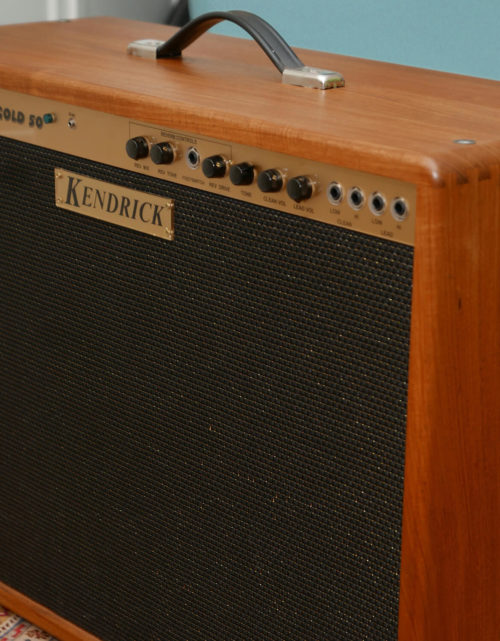 This was one of the best amps ever made by the legendary Gerald Weber. All-tube circuitry, designed and made in the USA, by Weber. It not only has power to spare (50 watts), but its unique circuitry has two channels, clean and lead, with different preamp circuit. These channels can be blended through patching the second input of one channel into the first input of the other, for purposes of blending the two channels together and further tone shaping with the interactive tone circuit. The bottom line: Tons of power if you need it, but the ability to get all the creamy, lush lead tones with the lead channel and/or blending. You just have to hear it. Original, handmade hardwood cabinet. 2 x 12: one 12 inch Kendrick brown frame and one 12 inch Kendrick black frame speaker. Kendrick's double spring reverb with three controls. Great condition. Recently serviced by one of the best amp techs in Texas. Price: $1495. No shipping. Local pickup only in Austin.
This was one of the best amps ever made by the legendary Gerald Weber. All-tube circuitry, designed and made in the USA, by Weber. It not only has power to spare (50 watts), but its unique circuitry has two channels, clean and lead, with different preamp circuit. These channels can be blended through patching the second input of one channel into the first input of the other, for purposes of blending the two channels together and further tone shaping with the interactive tone circuit. The bottom line: Tons of power if you need it, but the ability to get all the creamy, lush lead tones with the lead channel and/or blending. You just have to hear it. Original, handmade hardwood cabinet. 2 x 12: one 12 inch Kendrick brown frame and one 12 inch Kendrick black frame speaker. Kendrick's double spring reverb with three controls. Great condition. Recently serviced by one of the best amp techs in Texas. Price: $1495. No shipping. Local pickup only in Austin. -
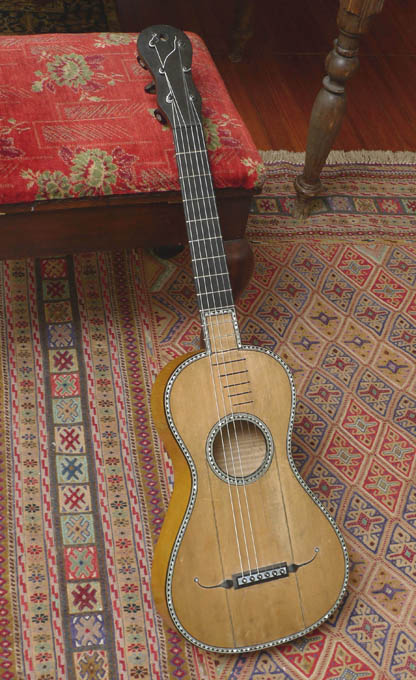 This fine and early example of the French guitar was made in Mirecourt, France, around 1800 to 1810. And sold through the famous Parisian dealer Koliker. It is a rare early example, as indicated by its rectangular bridge that does not have a separate saddle, but uses the top edge of the ebony rectangle as the saddle (this feature places it circa 1800, not like the more common 1820-1840 French guitars that have a more modern style bridge including a regular saddle). But for all its rarity, and exoticism to modern eyes, the most salient feature of this guitar is that it plays wonderfully. This is no museum piece to hang on a wall or shelf. This guitar is to play and enjoy. It plays beautifully, with all frets in tune. With no buzzing... I have had guitars from the 1960’s that do not play as well, in tune, and sound as well as this one. Even the action is perfect. The guitar has a wonderful tone, with a sweetness and brightness from the maple, and full bass response.
This fine and early example of the French guitar was made in Mirecourt, France, around 1800 to 1810. And sold through the famous Parisian dealer Koliker. It is a rare early example, as indicated by its rectangular bridge that does not have a separate saddle, but uses the top edge of the ebony rectangle as the saddle (this feature places it circa 1800, not like the more common 1820-1840 French guitars that have a more modern style bridge including a regular saddle). But for all its rarity, and exoticism to modern eyes, the most salient feature of this guitar is that it plays wonderfully. This is no museum piece to hang on a wall or shelf. This guitar is to play and enjoy. It plays beautifully, with all frets in tune. With no buzzing... I have had guitars from the 1960’s that do not play as well, in tune, and sound as well as this one. Even the action is perfect. The guitar has a wonderful tone, with a sweetness and brightness from the maple, and full bass response.- All original finish on the guitar
- Flamed solid Maple back and sides
- Spruce top, with no finish on the spruce… this is a characteristic of guitars from this time and place. While the back and sides of the guitar were French polished, the spruce top was left as natural wood, with no finish.
- One of the friction pegs is a modern replacement
- The two dark splices on the soundboard are later, but still 19th century, restorations, done as decorative flourishes.
- Scale length: 64.3 cm
- Length of body: 43.3 cm
- Koliker, Luthier Rue Croix-des-Petits Champs No. 24 A. Paris
-
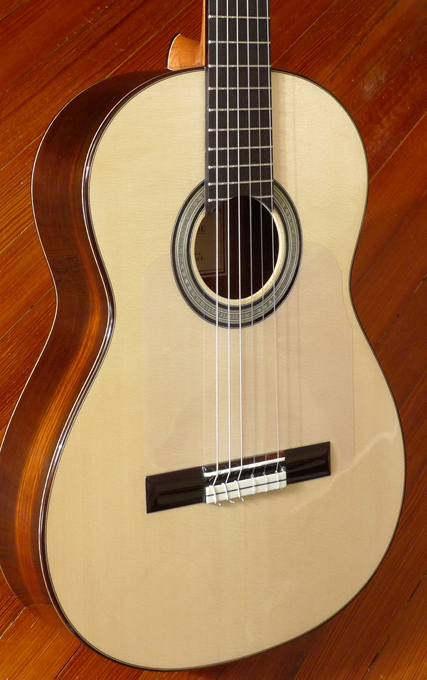 This new, custom made Lester Devoe Flamenco Negra is amasterpiece, from one of the world’s top luthiers. Lester Devoe needs nointroduction to the world’s great Flamenco players. The late, legendary Sabicasplayed a Devoe– and converted some of the great Flamenco players in Spain tothe fold. Paco De Lucia, and Vicente Amigo, among others, play Devoe Flamencoguitars. Paco De Lucia began playing a Devoe Negra guitar years ago– and thereare many Paco De Lucia recordings and feature films where Paco plays a DevoeFlamenco guitar.) This is the second custom guitar, that Lester has made for uswith select, old growth, quartersawn AAAAA Brazilian rosewood. Signed by LesterDevoe, 2012 (March).
This new, custom made Lester Devoe Flamenco Negra is amasterpiece, from one of the world’s top luthiers. Lester Devoe needs nointroduction to the world’s great Flamenco players. The late, legendary Sabicasplayed a Devoe– and converted some of the great Flamenco players in Spain tothe fold. Paco De Lucia, and Vicente Amigo, among others, play Devoe Flamencoguitars. Paco De Lucia began playing a Devoe Negra guitar years ago– and thereare many Paco De Lucia recordings and feature films where Paco plays a DevoeFlamenco guitar.) This is the second custom guitar, that Lester has made for uswith select, old growth, quartersawn AAAAA Brazilian rosewood. Signed by LesterDevoe, 2012 (March).- 650mm scale length
- Nut: 52mm
- Neck width at nut: 52mm
- 80 year old Brazilian Rosewood (pre-CITES) back and sides (Quartersawn).
- European spruce top
- Cedar neck
- Brazilian Rosewood headstock overlay, and bridge
- Brazilian Rosewood body binding, top and back
- Ebony fingerboard
- Sloane tuners
- Nitrocellulose lacquer finish
-
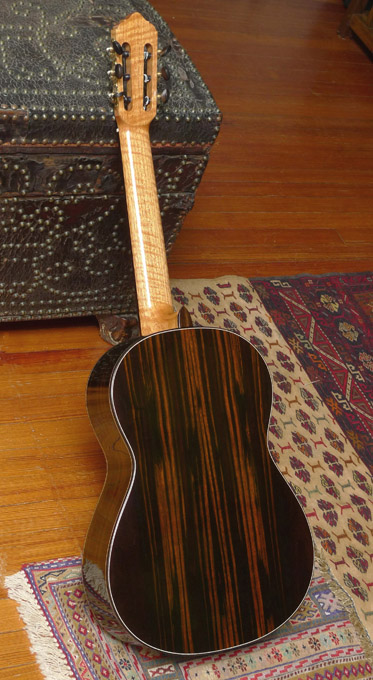 Vustom made Lester Devoe Flamenco Negra, a one-of-a-kind, Brazilian Rosewood guitar, from one of the world’s top luthiers. Lester Devoe needs no introduction to the world’s great Flamenco players. The late, legendary Sabicas played a Devoe– and converted some of the great Flamenco players in Spain to the fold. Paco De Lucia, and Vicente Amigo, among others, play Devoe Flamenco guitars. (I personally delivered a Devoe Flamenco Blanca guitar to Paco De Lucia in Spain in late 2010– Paco likes his Devoe’s hand-delivered. Paco De Lucia began playing a Devoe Negra guitar years ago– and there are many Paco De Lucia recordings and feature films where Paco plays a Devoe Flamenco guitar.) And it’s rare that Lester makes a Negra with Brazilian rosewood of this age and quality.
Vustom made Lester Devoe Flamenco Negra, a one-of-a-kind, Brazilian Rosewood guitar, from one of the world’s top luthiers. Lester Devoe needs no introduction to the world’s great Flamenco players. The late, legendary Sabicas played a Devoe– and converted some of the great Flamenco players in Spain to the fold. Paco De Lucia, and Vicente Amigo, among others, play Devoe Flamenco guitars. (I personally delivered a Devoe Flamenco Blanca guitar to Paco De Lucia in Spain in late 2010– Paco likes his Devoe’s hand-delivered. Paco De Lucia began playing a Devoe Negra guitar years ago– and there are many Paco De Lucia recordings and feature films where Paco plays a Devoe Flamenco guitar.) And it’s rare that Lester makes a Negra with Brazilian rosewood of this age and quality.- 650mm scale length
- Nut: 52mm
- Neck width at nut: 52mm
- String Spacing at nut: 44mm
- 80 year old Brazilian Rosewood (pre-CITES) back and sides (Quartersawn).
- European spruce top, with some beautiful and understated “"hazelfichte" (what Americans call bear claw).
- Custom, flamed Spanish Cedar neck
- Brazilian Rosewood headstock overlay, and bridge
- Brazilian Rosewood body binding, top and back
- Ebony fingerboard
- Sloane tuners
- Austere yet elegant Santos style black and white rosette, that Devoe uses only rarely, on top custom models
- Nitrocellulose lacquer finish
-
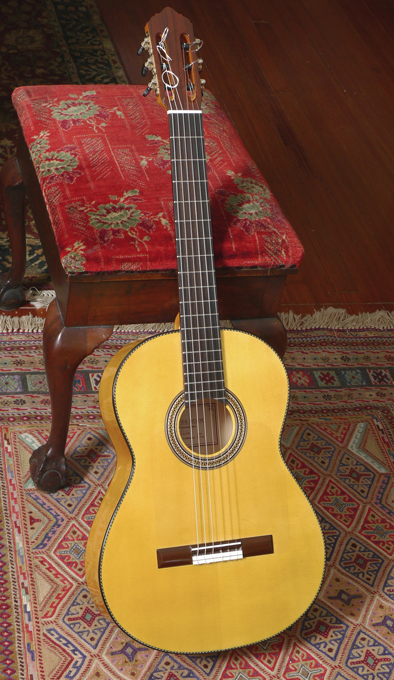 Brand new, Lester Devoe Flamenco Blanca, custom made (details on request). Lester Devoe needs no introduction to the world’s top flamenco players. His reputation was established decades ago (and his new models are the best ever made, and in huge demand worldwide). His guitars are played by the world’s top performing and recording flamenco artists. This instrument, custom made with a unique Spanish Cypress to add a more robust treble response to the legendary deep, throaty, percussive bass response of the Devoe Blanca, will amaze.
Brand new, Lester Devoe Flamenco Blanca, custom made (details on request). Lester Devoe needs no introduction to the world’s top flamenco players. His reputation was established decades ago (and his new models are the best ever made, and in huge demand worldwide). His guitars are played by the world’s top performing and recording flamenco artists. This instrument, custom made with a unique Spanish Cypress to add a more robust treble response to the legendary deep, throaty, percussive bass response of the Devoe Blanca, will amaze.- Flamenco Blanca
- 650mm scale length
- Spanish cypress back and sides (custom, details on request)
- European spruce top
- Ebony fingerboard
- Sloane tuners
- Rosewood headstock veneer
- Cedar neck
- Nitrocellulose lacquer finish
-
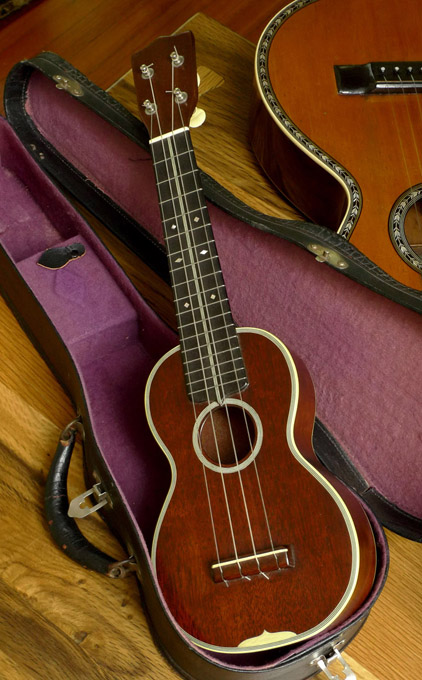 In the 1920’s and early 30's, the Hawaiian craze was in full bloom, and ukulele production was crucial to Martin’s success in this period. This is a wonderful, extremely well-preserved example of one of the most ornate of the Martin ukuleles, still in its original Geib case. Although Martin ukes built after 1916 carried no serial number, it’s possible to generally date them by stylistic elements. This Martin Style 3 is from the best era, the golden era, from about 1925 to 1930. Martin style 3 was first made in 1918. Martin Style 3, soprano (standard) specs:
In the 1920’s and early 30's, the Hawaiian craze was in full bloom, and ukulele production was crucial to Martin’s success in this period. This is a wonderful, extremely well-preserved example of one of the most ornate of the Martin ukuleles, still in its original Geib case. Although Martin ukes built after 1916 carried no serial number, it’s possible to generally date them by stylistic elements. This Martin Style 3 is from the best era, the golden era, from about 1925 to 1930. Martin style 3 was first made in 1918. Martin Style 3, soprano (standard) specs:- Mahogany body
- 7 layer top binding
- 3 layer back binding
- Ebony fretboard
- 5 layer soundhole ring
- Celluloid ornament on top, behind bridge (known as the "parend", or “shield”)
- Bar frets
- Small pearl paired-diamond inlays at fret 5, 7, and 9
- Three lines inlaid down center of fingerboard
- Nickel plated pegs (introduced in 1923)
- CF Martin & Co, stamped on back of peghead, and inside-back (Martin logo was not put on front of peghead until 1932)
-
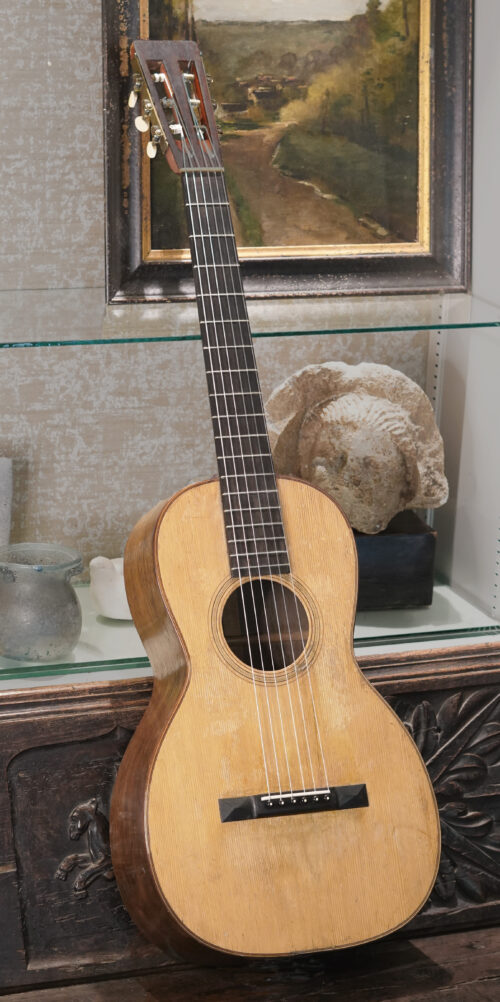
In this period, the Martin factory foreman often wrote the date of manufacture, before the guitar left the factory, hand-written in pencil on the underside of the top. This one has hand-written inside "5 / 1886". It’s a nice touch to a great Martin – and the size 2 is a great size, it’s a larger guitar than the more common size 2 ½ from this era.
Exquisite tone from this guitar. See and hear this guitar being played:
All careful work has been done on this guitar, including a perfect ebony bridge by T.J. Thompson, and it won’t need anything else. It’s an ideal guitar for the player who wants the best Martin tone and playability – a tonal gem from the 19th century Martin factory in Nazareth.
• Slot head, with original geared tuners
• Spruce top over Brazilian Rosewood back and sides.
• All original finish, with the exception of some minor touch up in the bridge area.
• Perfect reproduction ebony, pyramid bridge by T.J. Thompson.
Some touch-up in the bridge area of the spruce when the bridge was fitted.
• Fan braced – as are most of the best sounding Martins from this era.
• Original thin maple bridge plate, that has had some minor pin hole attention, by us, to ensure stability and protection from ball ends.
• Original ebony fretboard; Original bar frets. Frets have some wear, but we left them, for originality, and they play fast and low and smooth.
• Spanish heel (not the ice cream cone heel of the less expensive Martins of the era).
• Soft V neck
• End pin is original, tab end of the pin has come off but the shaft remains
• One inch area in the rosette, repaired (see photos)
• Three tiny holes near end pin are remnant of a tailpiece used at some point in the previous century
• One crack on top, just below the low E string (see photos). About 4 1/2 inches long. This crack has been glued, and is tight (no cleat due to proximity to a brace).
• Scale length: 24.5 inches
• Width at lower bout: 12 inches
• Nut width: 1 13/16 inch
The guitar has had a recent neck set (by us), so the action is great, and lower than what a lot of folks try to get away with on a 19th century Martin. This guitar does not have “classical guitar action.” The great Martins from this era were not then and they should not today be considered “classical guitars”. They are parlor guitars, and the best examples have the Martin sound we know and love, with a “classical” sound if we consider that sound from the 19th century not today.
No excuses on the action, tone, and playability on this guitar. Strung with Savarez Alliance strings. It plays so easily, with perfect intonation all the way up the fretboard, and the sound is stellar.
It ships in a modern hard shell case.
Price: $6,750. – plus shipping
-
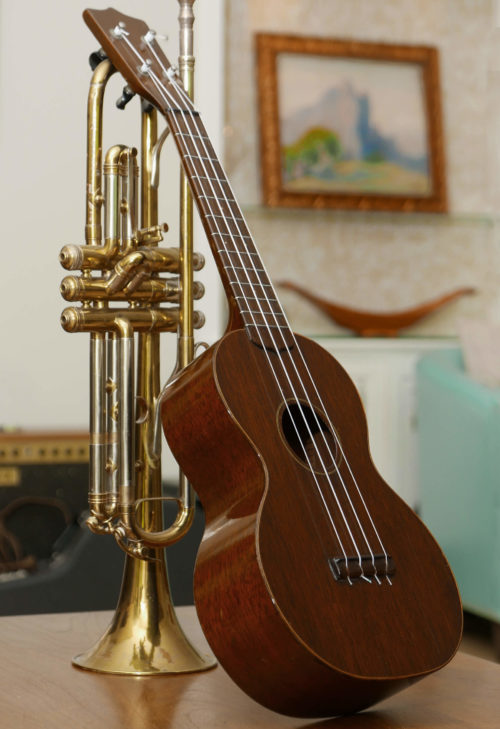 A beautiful example of one of the rarest prewar Martin ukuleles. This is a prewar Martin C-1. (All Concert Model ukuleles from Martin– with the exception of few special orders– were style 1). Officially called the Concert model ukulele, it’s larger than the many soprano size ukes. It’s very rare to find a prewar C-1 on the market– and much rarer still to find a pre-1933. This instrument was made between 1925 and 1933– because of the Martin stamp on the back of the headstock and the lack of the (post-1933) Martin decal on the front of the headstock. This is currently the only Martin C-1 from the late 1920’s on the market. And the tone and playability are perfect. Louder, and more bell like tone than a Martin Style 1 soprano uke. Martin concert ukuleles are the same body size as taropatch (1918-1932) but with four strings only. While the taropatch had been offered with four strings since its introduction, the new concert model was different in that it had a narrower neck and a standard soprano-size bridge. It was added to the standard catalog that year and by 1927 it was outselling all taropatch models combined. Concerts ukuleles are tuned the same as the sopranos but because of the larger body have a deeper and richer sound, and a slightly longer, easier to play scale length of 14 3/4". The Concert Ukulele from Martin–while rare to find a prewar example– is considered the ideal size for players– larger than the tiny soprano but not too big like the Martin Tenor uke. This one has a rich, beautiful tone, and it’s almost unplayed condition. The action is perfect. There is one small crack on top–but it’s essentially “cleated” by the orignal bridde plate and does not need addressing, and a smaller finish crack that does not go through to the inside). The braces and all else inside: pristine. And it even comes in its original canvas case. Like most Martin ukes, the mahogany bridge had some wear on the string slots. So we created a new, replacement, 100% historically correct replacement bridge. Original patent tuners Original ebony nut Brazilian rosewood fretboard Style 1: all mahogany, with brazilian binding on top Total length: 23 ¼ inches Body length: 11 inches Body width upper bout: 5 ¾ inches Body width lower bout: 7 5/8 inches Scale length: 14 ¾ inches Price: with original case. $2150.
A beautiful example of one of the rarest prewar Martin ukuleles. This is a prewar Martin C-1. (All Concert Model ukuleles from Martin– with the exception of few special orders– were style 1). Officially called the Concert model ukulele, it’s larger than the many soprano size ukes. It’s very rare to find a prewar C-1 on the market– and much rarer still to find a pre-1933. This instrument was made between 1925 and 1933– because of the Martin stamp on the back of the headstock and the lack of the (post-1933) Martin decal on the front of the headstock. This is currently the only Martin C-1 from the late 1920’s on the market. And the tone and playability are perfect. Louder, and more bell like tone than a Martin Style 1 soprano uke. Martin concert ukuleles are the same body size as taropatch (1918-1932) but with four strings only. While the taropatch had been offered with four strings since its introduction, the new concert model was different in that it had a narrower neck and a standard soprano-size bridge. It was added to the standard catalog that year and by 1927 it was outselling all taropatch models combined. Concerts ukuleles are tuned the same as the sopranos but because of the larger body have a deeper and richer sound, and a slightly longer, easier to play scale length of 14 3/4". The Concert Ukulele from Martin–while rare to find a prewar example– is considered the ideal size for players– larger than the tiny soprano but not too big like the Martin Tenor uke. This one has a rich, beautiful tone, and it’s almost unplayed condition. The action is perfect. There is one small crack on top–but it’s essentially “cleated” by the orignal bridde plate and does not need addressing, and a smaller finish crack that does not go through to the inside). The braces and all else inside: pristine. And it even comes in its original canvas case. Like most Martin ukes, the mahogany bridge had some wear on the string slots. So we created a new, replacement, 100% historically correct replacement bridge. Original patent tuners Original ebony nut Brazilian rosewood fretboard Style 1: all mahogany, with brazilian binding on top Total length: 23 ¼ inches Body length: 11 inches Body width upper bout: 5 ¾ inches Body width lower bout: 7 5/8 inches Scale length: 14 ¾ inches Price: with original case. $2150. -
 When this concert guitar was made in 1976, it was the top model offered by the master luthier Masaru Kohno– when he was at the very height of his career. There is some confusion out there as to which Kohno was the “top” concert model at any given date in height of Masaru Kohno’s career– from the early 70’s to the late-80s’. No confusion here– as there is correspondence (from August 2011) directly from Masaki Sakurai to us, regarding this guitar. Masaki Sakurai (nephew of Masaru Kohno, who in fact worked along side Masaru Kohno when this instrument was made in 1976, and now of course runs the “Sakurai/Kohno” shop, since the death of Masaru Kohno in 1998) confirms that this guitar was the top model available from Kohno in mid-1976. (Don’t be confused– a later, for example 1980 No. 30 Kohno is not a top Kohno model from that year. By 1980, the top model was a No. 50.) The confusion arises because Kohno had, in the early 70s until the late 80’s the custom of making his model numbers correspond to the guitars’ price in Japanese Yen. Hence, this guitar, a “No. 30”, in mid-1976, was priced at 300,000 Japanese Yen, and was the top model (a very expensive guitar in 1976). The confusion arises because as the inflation-prone 70’s continued, everyone adjusted prices upward. When inflation kept advancing, Kohno model numbers were something of a moving target, and the “top model” number changed upwards over time. Over time the top model moved up to No. 30 (this guitar), and then later No. 50 (starting in 1977). Kohno finally stopped using numbers in the 80’s and then called the top model the “Professional J”, and on, with more variations of “Professional”.) In any case this guitar, was the top model made, when it came from the Kohno shop (correspondence from Masaki Sakurai confirming this, will be supplied). But the real proof is in the playing. This instrument stands along with the best brazilian rosewood/spruce concert guitars from any maker, anywhere, any period. Crystal clear brazilian trebles. Wonderful resonance, combined with superior string separation.
When this concert guitar was made in 1976, it was the top model offered by the master luthier Masaru Kohno– when he was at the very height of his career. There is some confusion out there as to which Kohno was the “top” concert model at any given date in height of Masaru Kohno’s career– from the early 70’s to the late-80s’. No confusion here– as there is correspondence (from August 2011) directly from Masaki Sakurai to us, regarding this guitar. Masaki Sakurai (nephew of Masaru Kohno, who in fact worked along side Masaru Kohno when this instrument was made in 1976, and now of course runs the “Sakurai/Kohno” shop, since the death of Masaru Kohno in 1998) confirms that this guitar was the top model available from Kohno in mid-1976. (Don’t be confused– a later, for example 1980 No. 30 Kohno is not a top Kohno model from that year. By 1980, the top model was a No. 50.) The confusion arises because Kohno had, in the early 70s until the late 80’s the custom of making his model numbers correspond to the guitars’ price in Japanese Yen. Hence, this guitar, a “No. 30”, in mid-1976, was priced at 300,000 Japanese Yen, and was the top model (a very expensive guitar in 1976). The confusion arises because as the inflation-prone 70’s continued, everyone adjusted prices upward. When inflation kept advancing, Kohno model numbers were something of a moving target, and the “top model” number changed upwards over time. Over time the top model moved up to No. 30 (this guitar), and then later No. 50 (starting in 1977). Kohno finally stopped using numbers in the 80’s and then called the top model the “Professional J”, and on, with more variations of “Professional”.) In any case this guitar, was the top model made, when it came from the Kohno shop (correspondence from Masaki Sakurai confirming this, will be supplied). But the real proof is in the playing. This instrument stands along with the best brazilian rosewood/spruce concert guitars from any maker, anywhere, any period. Crystal clear brazilian trebles. Wonderful resonance, combined with superior string separation.- Hand-signed on label by Masaru Kohno, and dated 1976
- Solid European spruce top
- Solid Brazilian rosewood back and sides
- 660mm scale length
- Nut: 52mm
- Mahogany neck with 2 ebony supporting strips
- Ebony fretboard
- Gold engraved Gotoh tuners
- One repaired crack on back of guitar
- Crack-free top and sides. There are various nicks, dings, and scratches.
- Finish is naturally worn off, through playing, on the center section of the back of the neck– giving it a very fast feel in the left hand.
-
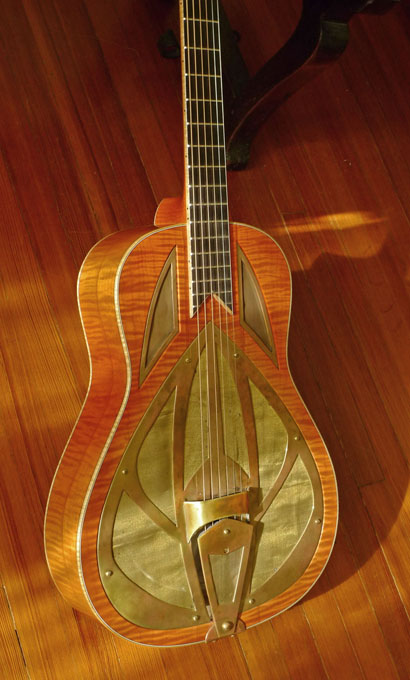 This stunningly beautiful, one-of-a-kind custom built resonator (from 2006, in beautiful crack-free condition and with only light wear) is from Tony Nobles, well-known luthier, and maker of instruments for Joe Walsh, Billy Gibbons and many other artists. The art deco ornamentation compliments an incredibly well built instrument, with meticulous attention to detail. Listen to/watch the video clip where guitar master Redd Volkaert put this instrument through some interesting jazz and blues paces.
This stunningly beautiful, one-of-a-kind custom built resonator (from 2006, in beautiful crack-free condition and with only light wear) is from Tony Nobles, well-known luthier, and maker of instruments for Joe Walsh, Billy Gibbons and many other artists. The art deco ornamentation compliments an incredibly well built instrument, with meticulous attention to detail. Listen to/watch the video clip where guitar master Redd Volkaert put this instrument through some interesting jazz and blues paces.- Spun-aluminum Quartermane biscuit-style cone (single-cone resonator)
- Solid curly maple, back top, and sides, with light tobaccoburst nitrocellulose lacquer finish
- Art deco coverplate, soundholes, and tailpiece of antiqued brass with a metal mesh covering
- Maple binding on body
- Custom torch inlay on headstock
- Curly maple neck
- Waverly tuners
- Scale: 24.4 inches
- Nut width: 1 7/8 inch
- String spacing at nut: 1 18/32
- Bridge spacing: 2 1/8
- Lower Bout: 14 1/2
- Upper bout: 9 1/2
- Body depth at bottom: 3 ¾ inches
- Body depth at neck joint: 3-20/32